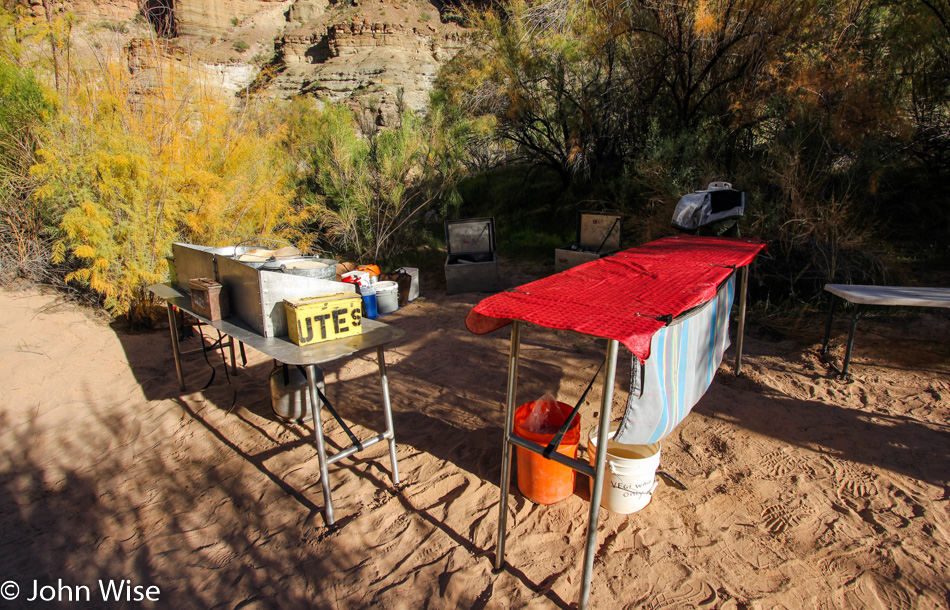
My brain commands my fingers to remain motionless lest the movement tears painful cracks into my parchment-thin, dry skin. Zippers are wicked little devices best operated by nimble digits, not sore, numb fingers on the verge of a blood offering. Still, someone must zip up our gear and finish packing. As bad as it is now, it is going to get worse. The clasps that secure the tent to the tension poles must be undone. Our fingers want to fail; they are unable to apply the strength needed to unlatch the locking mechanism, so we try the side of a knuckle or edge of the thumb to give leverage, hoping that there will be enough spring in the downward compression for the hook to pop up and away before we can tackle the next clasp.
Our hands may be what suffers most on this trip. The boatmen are unambiguous when it comes to clean hands, “We do not want any type of potentially debilitating virus to infect one of us or worse, the entire group.” This has happened in years past and motivates our guides to ensure it doesn’t happen now. The need to have a Groover nearby and ready to be deployed at all times due to explosive “number 3s” is a challenge. We do not want fecal contamination from unwashed hands to grind our river trip to a halt, as one’s own inner river of fury is a rapid no one wants to ride. Everyone must wash their hands following toilet use. Before getting in line for food, we must wash them again, even if we just came from the handwashing station near the toilet. Then there are the two hot meals a day that require us to wash and rinse our dishes.
Regarding the dishes, I should take a moment to describe how our kitchen operates. Three collapsible steel tables are used for breakfast and dinner preparation and presentation. One table holds the stove where water is boiled, a grill set up, pots, pans, and skillets are staged. On the same table, a Dutch oven will stand ready to hold warm pancakes or other delectables as they are set aside until enough are ready to be served to the group. The second table serves two purposes; first, it is the food prep area where a small number of people may lend a hand to slice and dice veggies, then, when the meal is ready, it is transformed into the serving table.
The third table holds another bane of our hands: the dishwashing station. On top of the table sit four galvanized tin washtubs. On the ground at one end stands a trash can for the food scraps left on dishes. Prior to our meal, water was taken from the river and allowed to settle. Some of that water is then brought to a boil on the stove before being used to fill the first three of the tubs. The fourth one contains cold water, with a splash of finger-eating bleach added as a disinfectant. Each dish and utensil undergoes a four-step cleaning process. In the first soapy basin, the dish is scrubbed free of food; then the dish enters the second soapy basin for another scrubbing; from there, it is rinsed in the hot, soapless water and then transferred to being disinfected in the bleach water before ending up in a mesh bag strung under one of the other tables to drip dry.
Add this up. Wash your hands after the toilet, wash them again before eating, and back into the water they go to wash your dishes. On the dories, your hands are going to get wet along with most of the rest of you. Bailing out the dory, hands stay wet. Lunchtime, wash those hands again. Back on the river means more wet head-to-toe action. Pull into camp; if you bathe, you are going to get wet, including your hands. Dinner call, time to wash your hands, and when you’ve had your fill, wash your dishes one more time. Last call at the Unit, you know the routine.
I already knew before leaving for this trip that our hands would be wet and cold most of the time, not a good combination, so I did some research on how to best care for these delicate instruments. Internet forums for the obsessive-compulsive hand-washer seemed a good place to start. They recommended Cetaphil hand cream – I bought a pound. We put this lardy cream on no less than twice a day, sometimes as much as four times a day. While our fingers didn’t crack wide open, they were often quite painful and extremely sensitive when they weren’t numbed by the cold water.
Our feet weren’t used for washing dishes or needing to be washed after a visit to the toilet, but they, too, were wet for hours on end. Our first lesson regarding wet feet happened back on Eminence Trail, though we weren’t aware of it at that time. My advice from that experience for future whitewater newbies who want to hike the dusty trails: upon arrival in camp, get your river shoes off and start drying your feet immediately. Warm sand works great to that end. During those early days after leaving Lees Ferry, we did not get out of wet river shoes right away, and when we did, we pulled warm socks and our hiking boots over damp feet. With the excitement of our first big hike and the delirium of being in the Canyon, a large part of our logical brains was turned clean off. For this oversight, we paid dearly with blisters that would plague us for the duration of the trip.
The final consideration regarding water would be to give attention to your sensitive bits, especially those areas of skin where friction could create problems. You will be sitting in wet shorts, on wet benches, and not infrequently in lap-deep water. Coming from the river, we often hit the trail in moments where, depending on your particular body architecture, there should be consideration made for when or where diaper rash could raise its magic wand of discomfort. Raw thighs on the trail may give you the cowboy swagger that lends authenticity to an old west persona, but out here, trying to have fun, day after wet day, inflamed inner thighs will not take your mind off the blisters on your feet. Instead, you will feel pain from butt to toe. A lifesaver here that was suggested to me just before our departure was A & D Ointment. Seems that vitamin A and vitamin D suspended in a gooey salve work wonders; just ask any baby.
I may as well make a theme of this and move through more body stuff before putting this topic to rest. In the suggested packing list our outfitter sent us regarding what might be needed on a river trip, we were told to bring resealable plastic bags for our trash. We would be responsible for dragging our own rubbish from the Canyon. There is no central repository for waste on one of the rafts, nor are there campsite trash receptacles. In that very same inventory recommendation was the hint that we might want to consider bringing camp wipes. These are essentially oversized moist towelettes or baby wipes for adults. Camp wipes proved invaluable. As one begins to ripen to a potent odor, bringing offense to the olfactory, a thick, moist wipe comes to the rescue if one is hesitant to dip the parts in cold river water every other day.
The wipes even come with instructions suggesting that you use the man-sized towelette on your face first, just in case you blunder and accidentally use it on your butt before applying it to your face. I’m certain this couldn’t happen more than once. The camp wipe ritual proved almost fun as we would scrub our face, ears, and neck with the towel draped over a hand, creating an ochre-tinted handprint on the once pristine white towel, supplying us with seconds of amusement. The next swipes over various other parts of the anatomy will be left to the imagination of what visual details graced this now disgusting, greasy towelette. Pleasingly refreshed, we stuff the used and unsightly camp wipes into one of those resealable bags.
This process goes on for days. Between the occasional river baths on a sunny afternoon, this method of getting cleaned up, even using the wipes on our itchy heads as a kind of shampooing, proved to be a soothing balm for a person not accustomed to these hygiene deprivations. If this had been a summer trip, I’m sure the phenomenon I am about to describe would have struck us within a few days. The resealable bags, with their evil, despoiled wipes and various artifacts of trash, eventually developed a full-spectrum bouquet. It would only take one time unzipping one of these plastic bags bubbling in fermentation to convince you never to open this particular bag ever again. If you had up until this point been trying to be environmentally friendly and were attempting to use a minimum of these bags to conserve plastic waste, it would be on this day, at this very instant, that you would find yourself tossing that frugality, along with this pouch of wretched stench, into another resealable bag that you can’t zip shut fast enough. You stuff the fermenting pocket of unbearable putrefaction into another bag, and maybe yet another, as you now fear that these bags could somehow break open while packed in your dry bag, with the clothes that don’t smell a fraction as bad as this bag of malodorous rot. Don’t forget to have your spouse smell the thing before sealing and storing it for the duration of your trip.

Time to put the aches, pains, and foul odors behind me and get moving up the trail. We are on our way into National Canyon, the last of the narrow slots that we’ll be able to visit over the remaining 59 miles of our river trip. I feel as though I sipped from the bottle labeled “Drink Me” and have shrunken to insignificance when measured against the immensity of this wonderland. Moving away from the wide expanse of the beginning of the trail, the narrowing path brings us past seashells peering out at us through 335 million-year-old Muav Limestone. The next steps deliver me through the fossilized lungs of some giant stone creature of lore. I am on my way to the heart.
Someone forgot to carve a polite trail through this boulder-strewn oversized artery. We crawl over and around rocks, the size of tanks, walk through the creek’s cool, clear water, and step into the moist sand. Our hike through the canyon pries open the imagination. A single tree stands firm, pushing hard against a slab of limestone as it insists on taking hold of two handfuls of dirt that have collected in a crack on the solid rock. Defiantly, the leaves are coaxing the branches to extend the tree beyond its reach, as though it might one day be successful in finding its way to the sun.
We walk as a silent caravan of nature’s revelers, celebrating our good luck to be amongst a group of like-minded travelers who are showing the demeanor and respect of people in a library, a church, or a hospital. It must be the sense of awe that reduces our need for words, leaving us content to remain speechless. Maybe there is no language for that which is beyond comprehension?
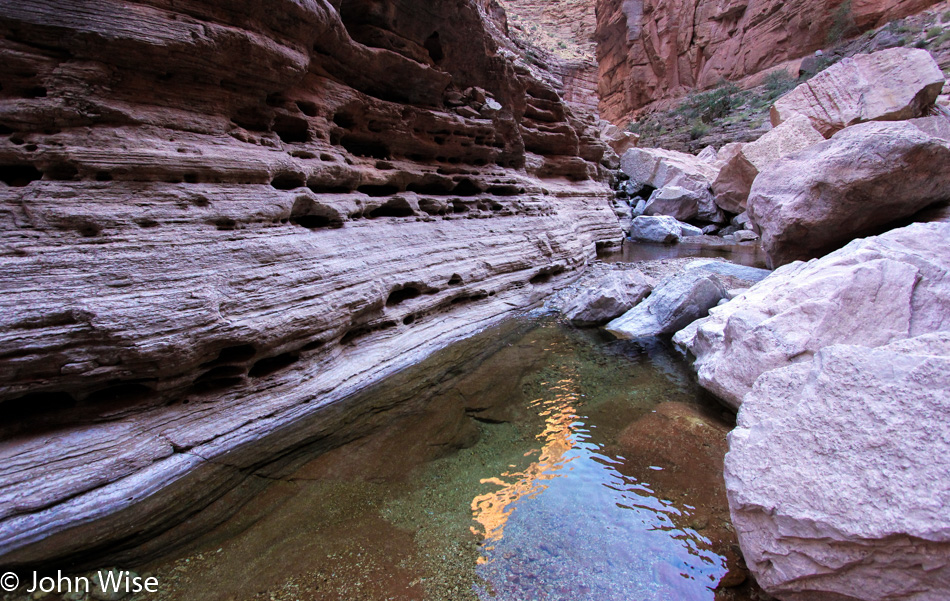
Our muted steps add to the well-worn edges of the illustriously smooth rock terraces. Beauty abounds where man-made noise does not distract the focusing mind. Is this reverence a buried instinct that once allowed our earliest human ancestors to explore their world and leave nothing more than a few mysterious symbols giving notice to others that someone else had passed through this land? Maybe there is no real need to despoil the environment when we are truly in the abundance of nature.

The outdoor, all-natural library of the Grand Canyon offers its vast wealth of knowledge to all who pass its towering bookshelves. All that is required is for us to open our minds to the invisible words writ large on the landscape and turn the page. On that next page, and below the steeple high above us, our walk takes us through the pews in a church, where our prayers are heard by the mighty ears of these canyon walls. The presence of nature is felt easily and experienced in tangible emotional ways. Some see this as the divine making itself known in an affirmation of what they knew was already there, although they might be in need of a reminder. For others, the emotional peaks and valleys of their own mind and soul may be an awkward first encounter with an awakening that is difficult to interpret or define.


The Canyon is also a hospital, offering us sanctuary to heal that which ails us. Psychic surgery is offered on the third floor, rebirth on the fourth floor, while humbling arrogance-ectomies are available free of charge on the first floor after you check in with Dr. Lee Ferry here at the Colorado Plateau Medical Center. Knowledge, spirit, and body are being restored here in the greatest of all intensive care units. Once reaching the 225th floor, you should be fully recovered and able to see life again with renewed clarity and vigor; good day and watch your step.

A little further up the trail, we reach the altar. This wasn’t supposed to be the end of our venture into these parts unknown, but a deep flooded pool is blocking our progress. Ahead, the slot canyon narrows into a twisting passage that leads further back into things begging at our inquisitive minds. Rondo tells us of the beauty that exists just beyond our view. We will have to leave only knowing his story of what has been shielded from our eyes. We are not to collect the cherry on top of the cake of experience this time, but the view we are offered at the end of this trail is sweet and yummy all the same.

We throw it in reverse, retracing our steps only to find ourselves in a parallel universe where things are the same, only different. Certainly, we are still in National Canyon, but hiking back to camp, the scenery, while familiar, does not seem to be precisely the one I just walked through. This works in my favor. My return to camp feels like a brand new trail, and the time saved from cutting this morning’s destination from our malleable schedule offers me more time to stroll along in leisure.
I cannot say that I have ever been more aware of the role of reflected light in changing the characteristics of a place as I am here, deep in the Grand Canyon. Up on the rim, it is precisely this charm of light and shadow spilling across the vistas that pulls folks out of bed early in the day to witness the sunrise and then again late in the day when they drop everything to watch the sunset as it bathes the Canyon in reds, purples, and burnt orange.

The late morning light is falling in a cascade of radiance, splashing downward from golden cliffs. The sun inches across the sky, its slowly changing light altering the terrain ever so subtly. The colors, shapes, texture, shadows, and complexity of features are undergoing an artful transformation that will have us questioning if the place we saw 20 minutes ago is the same one we are looking at now. This is a large part of the attraction that begs of us to linger, to absorb all we can in this rare moment we have been offered, to be present in this place.
Consider that during this particular moment, the vibrancy of color, the depth of shadows, and the reflection of what we bring to this experience will be interpreted differently, dependent upon the time of the week, month, or year when the sun is higher or lower in the sky. Clouds may be diffusing the light, or instead of being here in the morning, we might arrive at noon or late in the day. So, if someday you should find yourself standing right here, know that you are seeing the world in a way no one else has ever seen it before. Take a mental snapshot and compare it to what you thought you would see, and you will likely recognize a richness of detail that must have been put on display especially for you in your moment. You may never know this phenomenon, though, if you do not break out of your routine and find yourself somewhere in life, stumbling into the extraordinary.

We look into the infinite, trying to find meaning in the small corner of reality we occupy while simultaneously recognizing that we are sentient beings that have the ability to distill the universe into the observable. This is the wisdom of old nature.
I take a few steps forward, blink my eyes, and rub the disbelief from them. Yes, nature actually does coordinate itself in such delightful configurations. I’m not the only one noting this; Joe stands next to nothing in particular, looking at the rocks. Not just any rocks either; these are rocks that have captured Joe’s wonder. As he investigates the show of color and contrast between the shades and hues and everything else that brought him to a standstill, I stand here equally entranced, watching this man almost 30 years my senior, looking transfixed at the beauty he is taking in, much the same as I have felt so many hundreds, maybe thousands of times during the previous two weeks.

My wife, who I am sure was cut from the same cloth as me, is also lost in searching for details easily missed by the casual glances of those who walk through with nary more than a desire to have been here. Strangely enough, there are passengers who will not put themselves into every situation offered on these journeys, even when very little exertion is required. The impression given is that they may be here to humor someone else whose desire to be here was greater than their own. Caroline pulls me over, taking my attention from watching Joe in his curiosity in order to share with me something she is marveling at.

Water. The reflections, sparkles, ripples, splashes, and delicate sounds created when thin sheets of it are running over wild earth draw Caroline in to lose herself in the subtlety of the scene. In this fascination with detail, we were made for one another. Together, we follow the stream, watching in wonder as it meanders over the gray and purplish limestone. It enters and exits half-bowls and depressions, spills over shelves and ledges, and dips to swirl through seductive contours. Up ahead, it washes over short drop-offs, producing waterfalls an inch or two in height. We smile at each other with eyes that ask, “Can you believe how lucky we are?”
But we do know how lucky we are. The symbiosis found in our love has encouraged us to see the world and all of its beauty through four eyes, two hearts, and two smiles as we walk through life hand in hand. This act of sharing is a large part of the chemistry that has changed our perspective of what lies before us. During our exploration of the Canyon, my thinking matured, with the idea that extending our circle from two to many can have a positive effect on our ability to appreciate even more. Conversely, I believe it is loneliness that diminishes the vibrancy of our vision. Humanity is not programmed to go it alone. It is difficult to celebrate in isolation when you want to rejoice in the life emanating from your fascination. The art of images and the words from our language of exuberance turn to riches when they escape the confines of our hearts and are shared with others.
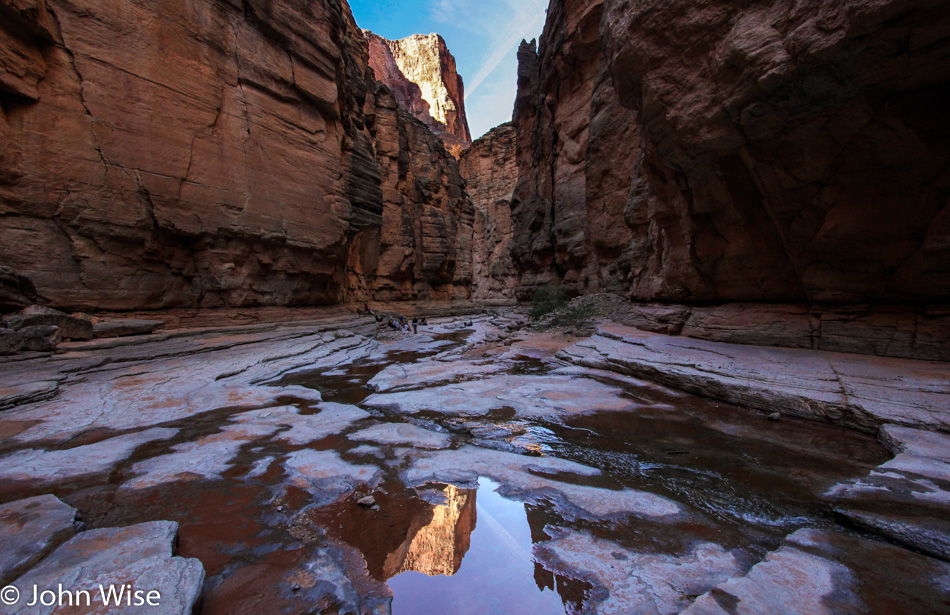
While I can see the magic of this place at work within my wife, amongst the boatmen, with Joe, Sarge, and the others, any open exchange or sharing of where we are inside is stilted and awkward, as though we have lost our ability to speak of what resonates deep within. It’s possible that nothing meaningful is lost from this lack of expression; intuition may be a more powerful force than we know. Maybe real communication has been crippled due to our obsession with the superficial nonsense of episodic television or worthless statistics easily parsed and used as a poor example of knowledge of important things. How is it that as a species claiming self-cognizance, with an ability to manifest an impact on its own destiny, we have dissolved our sense of community while simultaneously creating ever greater population densities? Why does the mass of an urban society foster anonymity, breaking up hope for a thriving, cohesive environment that should be functioning to bring us together? How can polarization and insignificance be considered an acceptable norm emerging from an intellect that is qualified to do so much more? We are destroying the air, water, land, and the quality of life for other species, and in all likelihood, our own too. Is this how we display the current apex of our hope and potential? How did pettiness, greed, and division overtake our capacity to know better? It has been the compassion, determination, and a love of life that sustained humankind through plagues, disaster, pestilence, starvation, war, and the other deprivations that have haunted our time on Earth; let’s hope our positive attributes can carry us through these difficult times, too.
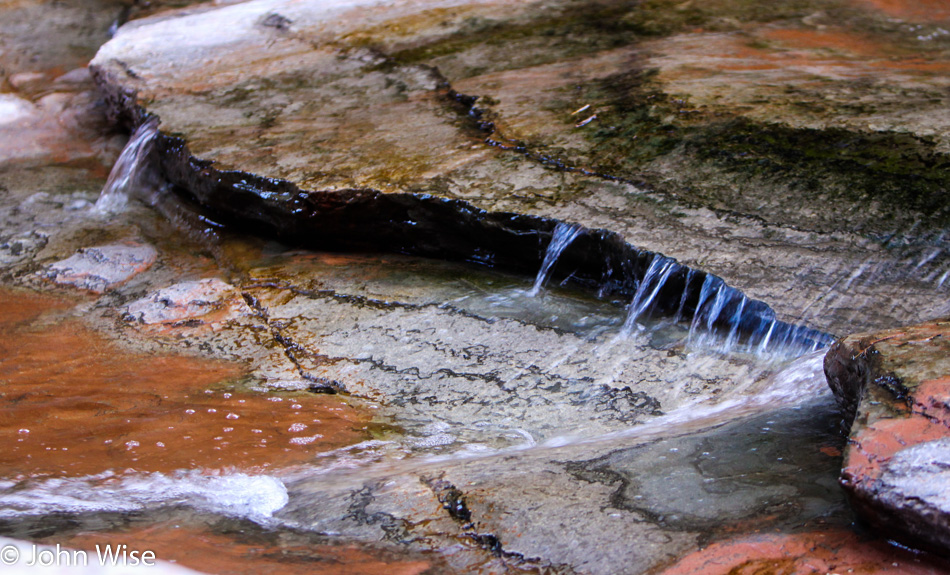
When will we throw off these shackles of stupidity? When will we remember what true friendship is and begin to move each other off the rock of arrogance, intolerance, and isolation? Our self-respect and sense of belonging need to survive beyond economic disasters, terrorism, and personal tragedy. I want to live in a community where I know my neighbors. I want to share in the telling of our adventures, epiphanies, and educational milestones, and I want to know the stories of my friends – not their viewing habits or the number of kills scored in their favorite video game. People shouldn’t have to feel abandoned and neglected by family and society alike as we race to possess stuff while failing to own the wisdom derived from kinship, positive experience, and community.
I do not purport to want a communist or socialist utopia. I understand that all things are not equal, but I also know how having nearly nothing is more tolerable when a shared sense of standing together with my fellow human beings will not leave me feeling abandoned and alone. Despair and civil ugliness are the only outcomes when the glue of community is weakened, and our sense of self-preservation is exploited. I would rather shed another tear for the beauty of nature and friendship than have to mourn for another random person who had to die in an act of violence caused by greed, intolerance, or fear.

This is where my thoughts are taking me when staring into the reflecting pool of my heart. It is what I see when watching fellow travelers embrace, who are still able to weep when overcome by a shared experience. My dreams, hopes, and aspirations push me to find a string of thoughts that will act as my mantra to maintain this state of perpetual awareness that nature wants us to reach so that we might glean a peek into our higher selves. With the love, sharing, and familiarity I find with my wife and friends, and ultimately with the world at large, I wish to see the day that the power of our hearts and convictions to do what is right will squash what is holding humanity back. If only we were as free as this water coursing over the limestone here in National Canyon, maybe then we, too, could attain this level of beauty.
Eventually, we must leave National Canyon and find ourselves back on the liquid highway, though glide time here is brief. Our trajectory points us to a muddy, wet riverbank and a steep hillside trail. Stepping from the dory into the mire, I wonder how deep I will sink and ask myself if this is the famous suck-mud that doesn’t easily release the extremity it captures. For me, with my camera clutched firmly, the objective is to not fall into the goo. I try to mimic the actions of the water striders that walk on the surface tension with quick light steps.
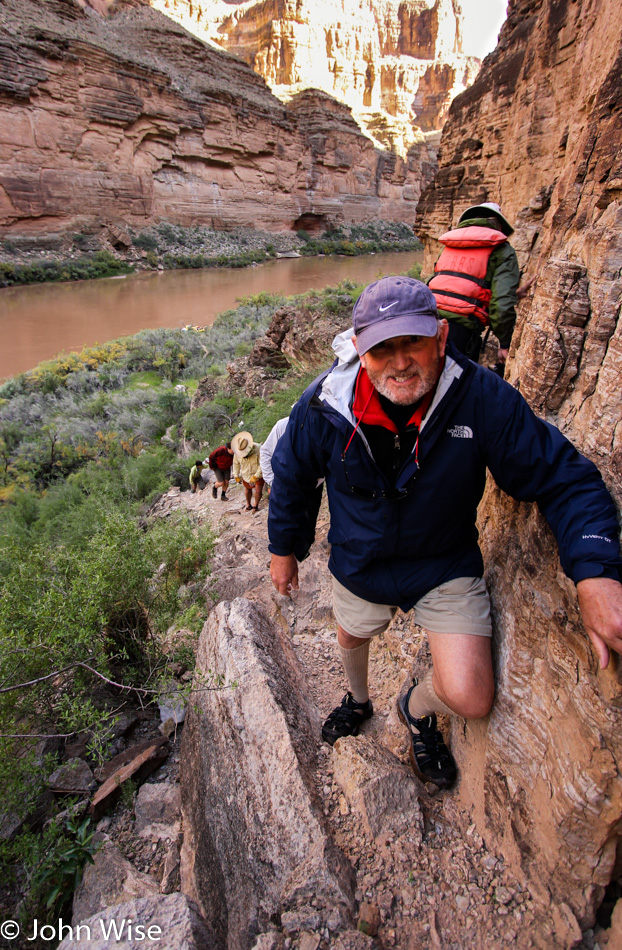
Once on dry, firm ground, I look back at the strategy of the others. I am impressed and in admiration of those who threw off their shoes and are experiencing all the tactile sensations of stepping into the cold mud gushing between toes and wrapping their feet in earth socks of fine sediment. Orange hard-plastic mallets hammer sand stakes into mud that quivers with every downward blow. With the boats secured to terra – almost – firma, we are ready to conquer another trail.
At the beginning of our hike, we cannot see where we are headed beyond a dozen feet in front of us. This has been true the entire trip, come to think of it. No one announces if we will travel half a mile, two miles, or five hundred feet. Where we stop, turn, or detour is always a surprise.
Thick brush lines the first section of narrow sandy trail until, a few minutes later, we reach a cliff face and a steep, even narrower, rocky path. The majority of the trails we find ourselves on are primitive and, at one time, were likely animal trails or the routes used by early inhabitants of the Canyon. Passing one another here on the cliff-side is not an option; the trail is strictly one way. A funny thing about perspective going up a trail is that they never look so steep. But once atop a spot where one can comfortably pause and catch a breath, looking back to see the others in your party, the sudden elevation gain is abundantly apparent and – for me at least – occasionally intimidating.
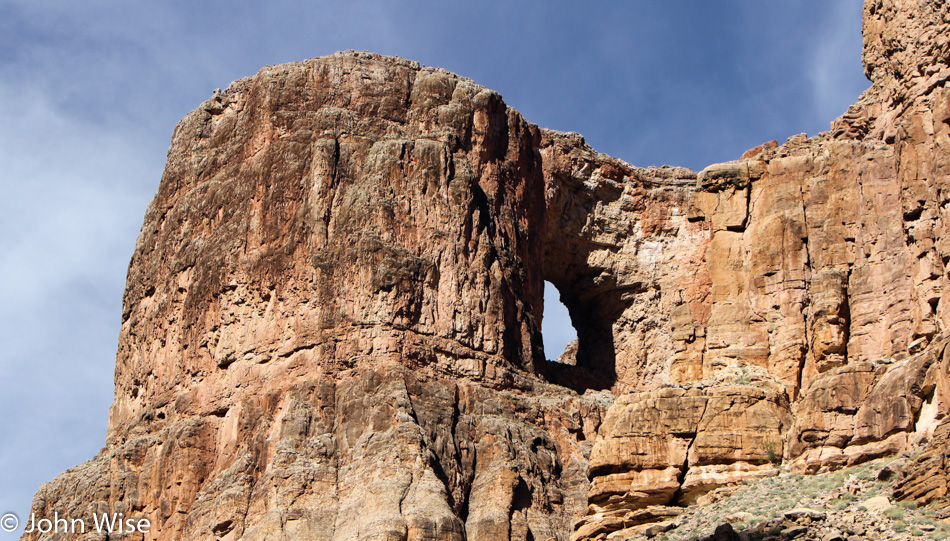
Thanks to the now-familiar knowledge that we have been traveling through layers of fossilized sediments, I am always on the lookout for signs of petrified plant and creature remains. Nothing from the distant past stands out here, though I’m sure given some time to do nothing but search for fossils, I would turn up something. Then, lying sandwiched between the sandstone layers next to the trail, an antique! It is a fragment, a piece of something larger; it is the broken metal housing of an outboard motor. This keepsake is the casualty of an encounter between hard rock and not so durable machine. Scratched into the metallic surface are some fading dates that tell us this motor met its end back in 1965. That it has been allowed to stay here, like a treasure sitting on a mantle, for more than 40 years without finding its way back off the river as a stolen souvenir is remarkable. I wish for it to remain a river memento for another 40 years, as a reminder of those pioneering early days of recreational exploration here on the Colorado.
The trail is short, but before we reach the optimal arch viewing area, there are views up and down river that are singing out to be seen. I oblige, giving audience to the symphony reciting this operetta of gorgeous delight. The mud, brush, rocks, cliff, river view, blue sky, and the finishing touch of a crescendo offered by Alamo Arch all work in harmony to bring the piece into a cohesive whole. No longer is the hole in the rock a solo performer, nor is the sight of it the destination. We have been on a miniature expedition, playing a small part in the bigger journey. Even during these brief side excursions, I choose to go further than the most obvious end location. This philosophy is, in large part, the trail I have taken in life’s journey without ever really knowing the final destination.

Not far downstream from Alamo Arch, Below Red Slide Camp is a mere spit of land at river mile 176 (yes, “Below” is part of the name of the camp). It’s still early in the day but not late enough for the previous guests to have broken camp yet. The others who are hanging out did not arrive by boat or foot; they are intruders who landed on a wing; they are flies. Lots of flies; flies by the gross. A baker’s dozen would have been tolerable, but these pesky waste-eaters smelled a feast rowing in on the wind that signaled our arrival. A buzz of fly-shouting must have been broadcast far and wide that a ripe group was on approach because, by the time the rafts were unloaded and bags delivered to campsites, a horde of flies that had been lying in wait flew out to welcome our presence. The flies let us know in their raucous song of merriment how much they were enjoying the invitation to dine on the funk and detritus we carried to their dinner table. Caroline and I took the fly orgy as a clue that a bath was in order.

Leave the lavender Dr. Bronner’s behind; this cleaning requires the extra-strength spearmint funk annihilator. Stepping into the water, I tremble at the thought of the big day tomorrow and the reason we took an early camp – Lava Falls. This rapid of monstrous proportions is just out of sight, 3 miles downstream, but never too far from our imaginations. All of a sudden, I feel as though I’m preparing my body for the coroner, and the flies are a hint of what’s to come. No matter, I must clean up as I’m reminded of what my mother taught me: wear clean underwear every day, you never know when you might find yourself under the care of a paramedic or doctor. Looks as though the rest of the group shared the same lesson from their own mothers, with most everyone taking the opportunity for a shore-side sudsing this afternoon.
Here we are, sparkling and fresh from our dip in the Colorado, with no side canyon hike or any more rapids today to keep our minds distracted. No action in the kitchen either. Nothing much to do in this early camp but sit here, letting the tension mount and wondering what tomorrow’s white-knuckler at Lava Falls will deliver. About 75 miles ago, after passing through Crystal Rapid, we earned bragging rights that we were ABC – Alive Below Crystal. There can be no one who takes a river journey through the Grand Canyon who doesn’t know about the legend of the Canyon – Lava Falls. Tomorrow, we all hope to be ABL – Alive Below Lava. Our group has been lucky so far: no falls of consequence, no dreaded boat flips, no stomach viruses, no one overboard. If there is a rapid that holds all the potential of doom, it is surely our next ride.

On previous nights, Rondo’s review of the day and preview of what comes next has been held around the dinner hour. Tonight, he is giving his spiel with no food in sight. This can only be part of the tension ploy to ensure our senses are highly alert to be fully responsive early tomorrow. The announcement holds the nugget of surprise that we will be woken at 5:00 am, in the dark of the day. We will need to pack up faster than we have on any of the preceding days. Breakfast will be bagels and lox, to be wolfed down by the light of our headlamps. We are urged to visit the Unit and make quick business of things. The rafts and dories will be untied and launched by 6:30.
The goal is to thrust ourselves into the maelstrom of Lava by 7:30, to experience 23 seconds of controlled, reckless abandon, well, as much control as a boatman, two oars, and years of experience can bring to bear once we enter the madness of Lava Falls. Why so early? The daily water level fluctuations triggered up at Glen Canyon Dam will make Lava Falls more difficult to run as the flow decreases throughout the morning. In spite of my healthy dose of fear and respect for this infamous landmark, there is a part of me that wants us to make the run at minimum gnarly flow, to better flirt with death and danger.
It is now after 6:00 pm, and I lay prone in debilitating anxiety on the sand, writhing in anticipation, not for Lava Falls, but where in tarnation is dinner? The stove is working hard, and the Dutch oven is baking at its own slow, steady pace. Finally, a guitar arrives to serenade us – or to distract us from the long wait. Shortly afterward, the call goes out to wash them hands and start the lineup. Pork in green chile sauce, coleslaw, and the treat of all treats – Dutch oven cornbread – are on the menu.
This isn’t just any old dry, moisture-robbing, semi-edible desiccant one tries to choke down. This special recipe must be the cake Marie Antoinette lost her head for. Tonight, we dine on the deluxe cornbread of the comfort-food gods.
It would be unfair to now withhold this recipe, denying you the opportunity to taste the single greatest river treat I laid taste buds upon. Here it is:
1 Box Krusteaz Honey Cornbread Mix
1 Egg
1 Small Can Diced Green Chilies
1 15 ounces Can of Whole Corn – drained
½ to 1 pound of cheddar or cheddar-jack mix
Just enough milk to make a thick dough, between 4 and 8 ounces
1 stick of melted butter – Who cares about fat down here? We are working hard and are near the precipice of death anyway.
In a large mixing bowl, add the cornbread mix, egg, green chilies, corn, and milk. To add the cheese, break up the block into small pieces – about the size of small coins – and stir them into the batter. If you are making this at home, pour the melted butter into your baking dish, add the cornbread mixture, and bake at 375 degrees for approximately one hour. If you are making this in a Dutch oven in camp, fix a couple of paper towels into the butter-filled bottom to help in the removal of the cornbread. Place about eight briquets under the oven and about 20 on the cast iron lid – this all depends on the size of your oven. Bake for 45 minutes before cracking open the lid, as you do not want to let the heat escape. Stick a knife into the cornbread; if it comes out clean, the cornbread is finished; otherwise, replace the lid and cook for another 10 to 15 minutes. When the cake of corny delight is finished, grab a big stick to fend off your friends and family, who will attempt to come between you and your cornbread.
M&M’s are passed around for dessert as though they are needed. Now, in full-blown, carb-induced ecstasy, the thoughts of tomorrow’s tumult in the bowels of Lava Falls are far away. Approaching fast is a pillow and cozy sleeping bag that want to help celebrate cornbread euphoria – who needs sheep?
–From my book titled: Stay In The Magic – A Voyage Into The Beauty Of The Grand Canyon about our journey down the Colorado back in late 2010.